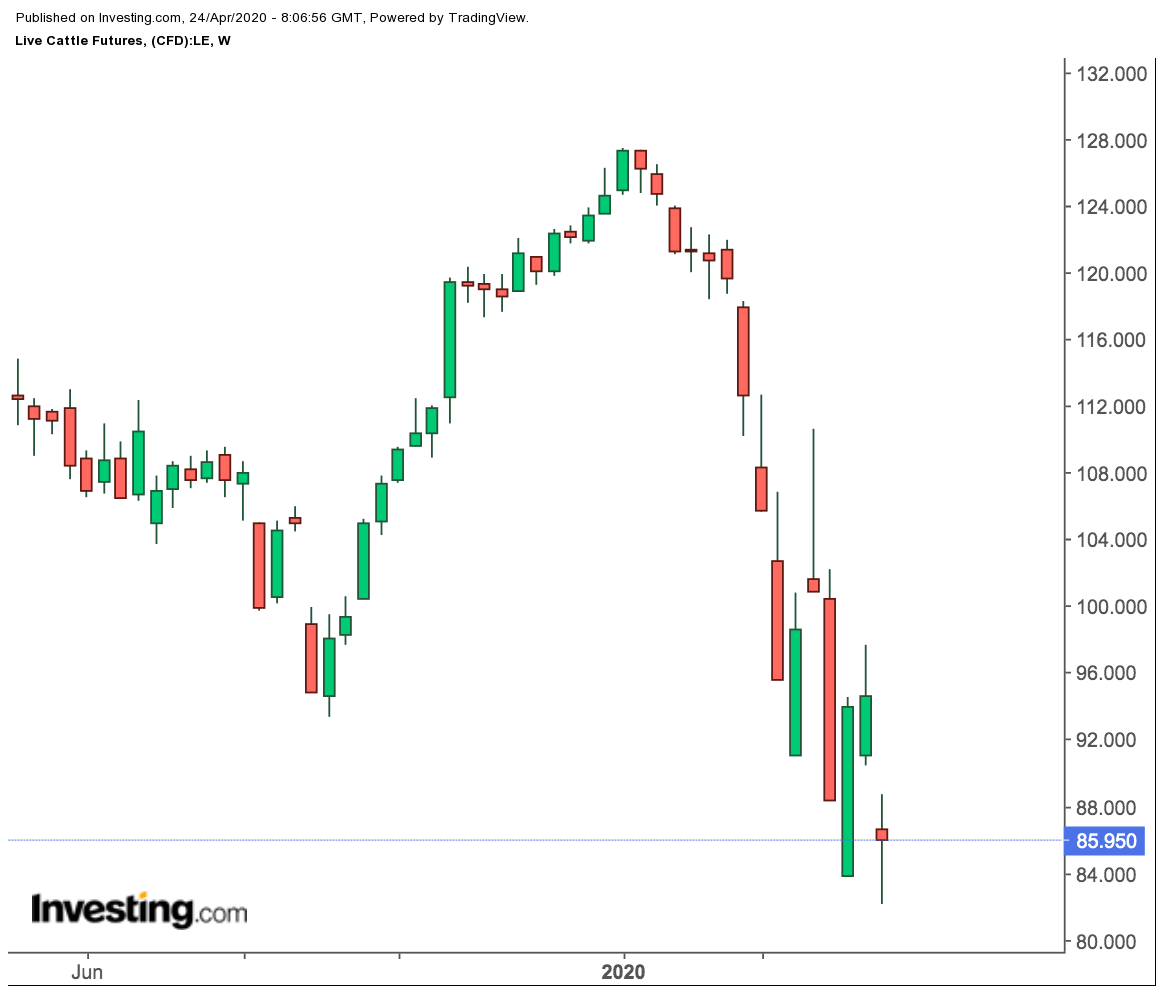Yes, pigs can fly. Don’t believe me? Just look at those lean hogs futures and how they’ve taken off. And if you’re long live cattle, I can totally understand your frustration now in asking, “what’s the market’s beef with that?”
Idioms are fun. But they can also relate profoundly to the life happening around us.
The coronavirus crisis has changed almost every aspect of our existence as we know it, with different outcomes for different things. In the livestock markets, futures of lean hogs are flying while those of cattle have hit ground with a thud due to contrasting fortunes from the universal squeeze on supply chains applied by the pandemic.
COVID-19 outbreaks have forced the closure of a string of hog processing plants in the United States run by JBS SA (OTC:JBSAY), the world’s top meat company, and U.S. giant Tyson Foods (NYSE:TSN), knocking out some 25% of America’s daily pork arrivals.
Tightness in Ham to Pork Sausages
The expected tightness in the supply of everything from ham to gammon to bacon to sausages has lit a flame under the Chicago Board of Trade’s hog market, which is headed for a record weekly gain of nearly 35% after a nonstop five-day rally.
On the cattle end, an estimated 20% of beef supply is also out due to a rash of coronavirus infections at other meatpacking plants for beef, also owned by JBS and Tyson, as well as privately-held U.S. grains company Cargill. 
Yet, CBOT’s cattle market is carrying a weekly loss of 9% after five straight days in the red. Why such disparity?
Beef Shortage Looming Too
Dan Hueber, a veteran ags trader in St. Charles, Illinois, who has followed the livestock market for more than 30 years, tries to explain:
“As of the end of March, frozen pork in cold storage totaled 621.9 million pounds, which was down 27 million pounds from February, more than double the normal reduction.”
“Beef supplies were actually up 8 million pounds for the month as slaughter numbers remained strong last month,” wrote the author of The Hueber Report, which covers an array of agricultural markets.
But the report also notes that supplies of frozen pork bellies alone rose 4.5 million pounds last month, which Hueber said “undoubtedly reflects the decreased traffic at restaurants, where we have learned, everything tastes better with some bacon.”
No Reason for Cattle to Get Raw Deal
In conclusion, he suggested the massive financial and logistical problems at the farm level created by the pandemic would result eventually in an across-the-board drawdown in frozen stocks — meaning cattle shouldn’t be getting the raw deal it is now.
Terry Reilly, a senior analyst with Futures International in Chicago concurs.
“For livestock, traders are still trying to figure out where to take this market given the uncertainty of meat demand for the rest of the year,” said Reilly. “It is unknown how much the restaurants will buy or take in over the next six to 12 months.”
The United Food and Commercial Workers International Union, which represents 80% of U.S. beef and pork production workers, affirms the problem is a national crisis for all meat-based foods: Thirteen of its unionized workers have died after contracting COVID-19 and 5,000 others have tested positive or been exposed to the virus.
All this suggests more upside to cattle prices than what we have now, pending today’s cattle report due from the U.S. Department of Agriculture.
Mike Seery, who plots technical charts for multiple commodities out of his Plainfield, Illinois office, says cattle appears to have set a decisive bottom three weeks ago, with the April 3 of 83.83 cents a lb. Friday’s settlement for the front-month cattle contract on CBOT was 85.95.
“Strong Sell” for Cattle Belies Fundamentals
Investing.com’s own Daily Technical Outlook still calls a “Strong Sell” on cattle, indicating further downside that could test support at 83.97. But it also lists a series of potential resistance from 91.27 to 93.58 and 94.92 should cattle break to the upside.
For lean hogs, Investing.com’s call remains a “Strong Buy,” with next resistance pegged at 51.20.
“I will be looking at a bullish position in cattle in the coming weeks ahead as prices have gone sideways over the last several weeks,” Seery wrote.
“Volatility has slowed down over the last week as we were experiencing tremendous price swings on a daily basis. Historically speaking prices look cheap in my opinion.”
Seery said the trend in cattle was still negative, with prices trading under the 20- and 100-day moving averages. But he also sees some promise from the reopening of businesses in a few U.S. states from this weekend that could boost demand in a tight market, adding:
“All of the poor fundamental news may have already been reflected into the price."
